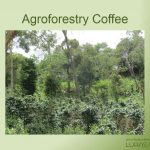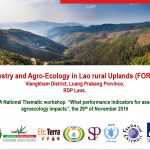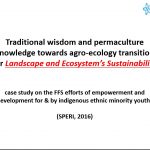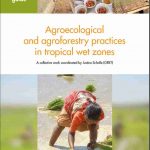
18 downloads
Title of document: Agroforestry Coffee Authors: RURAS Journal’s name if any: Ministry/Government Agency/Organisation: RURAS Year of publication: 2016 Geographic focus: Lao PDR Main issues / topics addressed (for example: Production and markets; Local strategy……) School of agroecology (if any): Web address to original document (if any): Summary: Presentation for a brief overview of RURAS “Agroforestry Coffee” in Xiengkhouang Province, Lao PDR Read More

13 downloads
Title of document: Forestry and Agro-Ecology in Lao rural Uplands (FORAE), Viengkham District, Luang Prabang Province, Lao PDR Authors: Journal’s name if any: Ministry/Government Agency/Organisation: MAF, AGRISUD International, ETC Terra, SAEDA, SPF, WFP, ENSEMBLE Fondation, AFC Year of publication: 2016 Geographic focus: Lao PDR Main issues / topics addressed (for example: Indicators are multi-sectoral…; Focus on…Environmental indicators; In brief, to summarize………) School of agroecology (if any): Web address to original document (if any): Summary: Presentation for ALiSEA National Thematic workshop “What performance indicators for assessing agroecology impacts”, the 29th of November 2016 Read More

5 downloads
Title of document: Dried Bamboo PGS Certified: from Huaphanh to Vietnam… A long journey Authors: HuaphanhBambooSectorDevelopment Project Journal’s name if any: Ministry/Government Agency/Organisation: ALiSEA, HuaphanhBambooSectorDevelopment Project Year of publication: 2017 Geographic focus: Lao PDR Main issues / topics addressed (for example: Situation of Nor Hok dried bamboo shoots cross-border value chain, challenges facedby norhokcross border bamboovalue chains……) School of agroecology (if any): Web address to original document (if any): Summary: The “Bamboo Provincial Strategy 2016-2020” for second phase has been approved by Provincial Governor. The Bamboo Project is facilitating the implementation this strategy Presentation for “Dried Bamboo PGS Certified: from Huaphanh to Vietnam… A long journey”, in Vientiane-ALISEA, 25 July 2017 Read More

9 downloads
Title of document: Traditional wisdom and permaculture knowledge towards agro-ecology transition for Landscape and Ecosystem’s Sustainability “case study on the FFS efforts of empowerment and development for & by indigenous ethnic minority youths” Authors: Journal’s name if any: Ministry/Government Agency/Organisation: SPERI Year of publication: 2016 Geographic focus: Vietnam Main issues / topics addressed (for example: Sustainability and Current Situation in Vietnam, Why traditional wisdom and permaculture knowledge for landscape and ecosystem sustainability?……) School of agroecology (if any): Web address to original document (if any): Summary: Presentation for traditional wisdom and permaculture knowledge towards agro-ecology transition for Landscape and Ecosystem’s Sustainability, SPERI Read More
2 downloads
Title of document: HELVETAS Swiss Intercooperation and HELVETAS in Myanmar “A Brief Overview” Authors: HELVETAS Swiss Intercooperation Journal’s name if any: Ministry/Government Agency/Organisation: HELVETAS Swiss Intercooperation Year of publication: 2014 Geographic focus: Myanmar Main issues / topics addressed (for example: About HELVETAS Swiss Intercooperation and HELVETAS in Myanmar…) School of agroecology (if any): Web address to original document (if any): Summary: HELVETAS Swiss Intercooperation was Founded in 1955 as first private Swiss development organization, 2011 merger with Intercooperation. We’re promotes multi-stakeholder and equitable partnership approaches, with special consideration given to strengthening local authorities, partners and communities to self determine and manage their own development over the longer term HELVETAS started scoping in 2010 and piloting in Myanmar in 2012. Main working areas are Rural Economy, Skills Development and Education, and Governance and Peace. Other working areas are integrated based on needs and added value. Presentation of HELVETAS in Myanmar Read More
6 downloads
Title of document: Development of NTFP Value chain (The case of the Hok Bamboo shoots development in Huaphan Province, Laos) Authors: Sara Melki Journal’s name if any: Ministry/Government Agency/Organisation: GRET, DPI, OXFARM, SDC Year of publication: 2016 Geographic focus: Lao PDR Main issues / topics addressed (for example: NTFPs as part of agroecology,natural resource and managerment sustaintable trade……) School of agroecology (if any): Web address to original document (if any): Summary: This presentation talking about Hok Bamboo shoots development, management and sustainable trade Read More
3 downloads
Title of document: Finding alternatives to swidden agriculture: does agroforestry improve livelihood options and reduce pressure on existing forest? Authors: Syed Ajijur Rahman . Jette Bredahl Jacobsen . John Robert Healey . James M. Roshetko . Terry Sunderland Journal’s name if any: Ministry/Government Agency/Organisation: Forest and Nature for Society (FONASO, initiated by the Erasmus Mundus programme of the European Commission to enhance and promote European higher education throughout the world) and Center for International Forestry Research (CIFOR). Bangor University, University of Copenhagen, and ICRAF Year of publication: 2016 Geographic focus: National Main issues / topics addressed (for example: Agroforestry, adoption Income, Social potential, Forest protection, Policy support ……) School of agroecology (if any): Web address to original document (if any): Summary: Swidden cultivation can contribute to deforestation and land degradation, which can subsequently result in a number of serious environmental problems. This paper examines the economic and social potential of agroforestry systems and the barriers to their widespread adoption, as a land use alternative to swidden cultivation, which may potentially help protect local forest. The Gunung Salak valley in West Java, Indonesia is presented as a case study. Based on farmers’ and experts’ assessment, costs and benefits have been estimated, which show that the two investigated agroforestry systems have higher net present value and benefit-cost ratio (B/C) than the two swidden cultivation systems. Tree ownership also creates more permanent rights to farmland and is prestigious in the community. Agroforestry products (fruit, vegetables etc.) have high monetary value and help strengthen social cohesion when shared with neighbors. However, farmers are reluctant to implement agroforestry. Stated reasons are related to both culture and capacity. Farmers practicing agroforestry are less involved in forest clearing and forest products collection than swidden farmers indicating that it may contribute positively to conservation of local forests. Increasing the adoption of agroforestry farming in the study area will require support to overcome capacity constraints. Read More

56 downloads
Title of document: Agroecological and agroforestry practices in tropical wet zones Authors: A collective work coordinated by Justine Scholle (GRET) Ministry/Government Agency/Organisation: GRET Year of publication: 2017 Geographic focus: Mekong Region and Central Africa Summary: This guide is designed as a support tool for technicians and farmers involved in actions to promote and develop agroecology. It is a follow-up to a first technical guide published in 2014 in the Democratic Republic of Congo as part of the DEFIV project, a food security project implemented by GRET, funded by the European Union and Agence française de développement. This guide features two parts: The first part presents the current context and issues of agroecology in tropical wet regions. Having demonstrated the limits of conventional agricultural systems, analysed the effects of deforestation, the green revolution and climate change, the authors specify the objectives and the principles of agroecology, and remind readers of the conditions necessary to promote it. The second part is very operational and covers the various agroecological techniques, which were tested in a tropical wet context with satisfying results in the Democratic Republic of Congo (DEFIV project), Cambodia (APICI project) and Myanmar (Delta and NRS projects). Firstly, the various agroecological techniques are presented, and secondly the plants used to implement these techniques are described. Naturally, techniques such as plant inventories mentioned in this guide are not exhaustive. Read More
16 downloads
Title of document: Shifting Forests in Northeast India: Management of Alnus nepalensis as an Improved Fallow in Nagaland. ALDER CHAPTER 30 Authors: Malcolm Cairns, Supong Keitzar, and T. Amenba Yaden Ministry/Government Agency/Organisation: the India-Canada Environment Facility (ICEF), the International Development Research Centre (IDRC), and the World Agroforestry Centre (ICRAF) Year of publication: Geographic focus: India Summary: This chapter describes an ancient but little-documented example of farmer manipulation of A. nepalensis in Nagaland, Northeastern India, which has enabled a significant intensification of the swidden cycle without concomitant ecological decline (see color plate 35). It offers a hypothesis that this intensification was partly prompted by security concerns in an atmosphere of intertribal warfare and headhunting, and gives a brief cultural profile of the main innovators, the Angami Nagas. Much of the historical detail is drawn from early reports by the British colonial government. These provide rich insights into the people of Nagaland and the historical environment that spawned the innovation of alder fallows. The chapter then focuses on a village in Kohima District of Nagaland as a case study, and provides a description of standard jhum cultivation as it is practiced in the region as well as a more detailed diagnosis of the alder fallow innovation. It draws on these findings to elucidate pertinent research issues and to examine the role this system could play in enabling intensification of shifting cultivation in a sustainable way across a broader landscape. If Asia-Pacific’s forest remnants and their contained biodiversity are to be protected, and swidden communities are to be afforded a better standard of living, pathways toward stabilizing and enhancing the productivity of stressed swidden systems are urgently needed. One of the most promising approaches to identifying biophysically workable and socially acceptable innovations is to document and understand indigenous adaptations toward improved fallow management. Read More
9 downloads
Title of document: Minutes of “Lao Bamboo & Rattan Platform” workshop, 15th and 16th June 2016 Vientiane, Lao PDR Author: Sara Melki Ministry/Government Agency/Organisation: GRET Year of publication: 2016 Geographic focus: Laos Summary: A Lao Bamboo & Rattan Platform workshop addressing the development of the bamboo and rattan sector in Lao PDR was held on the 15th and 16th of June 2016 in Vientiane capital, Lao PDR. It was co- organised by DoF/ MAF, GRET, WWF and RECOFTC. It brought together 38 participants from national and international NGOs, researchers and provincial and national governments agencies, development partners actively working on developing the bamboo and rattan sector in Lao PDR (see participants list in Annex). It aimed at defining and creating a dynamic Lao Bamboo & Rattan Platform for facilitating experience sharing among projects in the country in order to create a common vision, to act the willingness of a Lao Bamboo & Rattan Platform as well as to start the formulation of an action-plan of the Lao Bamboo & Rattan Platform for initiating a discussion on the national governance of the bamboo & Rattan value chains in Laos. The workshop was organized into 2 sessions: - - Presentation of the national forestry strategy, related to NTFP and bamboo and a review of main 6 bamboo and rattan projects implemented in Laos (short presentations) - - 2 discussions : --> Can we scale up the Houaphan experience to National sector development? What are our common vision and objectives on developing the bamboo sector in Lao PDR? Construction of a Lao bamboo sector governance, based on Huaphan Province experience --> What are main Functions and activities for the Lao Bamboo & Rattan Platform for the next 3 years? Read More

 Asia & Mekong Region
Asia & Mekong Region  Cambodia
Cambodia  Laos
Laos  Myanmar
Myanmar  Other
Other  Vietnam
Vietnam